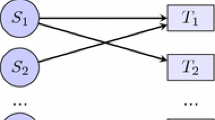Abstract
Many current studies in tracking and surveillance assume that a target can be monitored by a single sensor. However, there are situations where a sensor can only monitor a certain portion of the object. Examples include image capturing and coastline monitoring. In our previous work, we develop the Minimum Cost Cover algorithm to identify a set of sensors which preserve 360° coverage of a target with minimum cost, such that when different cost functions for the sensors are used, covers with different optimization objectives can be identified. In this work, we study the scheduling problem to monitor a target continuously with full angle coverage. To increase network lifetime, we develop several algorithms by adopting different cost functions in selecting the sensors. We evaluate the performance of our schemes through extensive simulations. The simulation results show that our proposed Conditional Scheduling metric can help to improve the network lifetime as well as the time to the first node failure.
Similar content being viewed by others
References
Alfieri, A., Bianco, A., Brandimarte, P., & Chiasserini, C.-F. (2004). Exploiting sensor spatial redundancy to improve network lifetime. In IEEE Global Telecommunications Conference (Globecom), pp. 3170–3176.
Awduche, D. O. (1999). MPLS and traffic engineering in IP networks. In IEEE Communications Magazine, pp. 42–47.
Cardei, M., Thai, M. T., Li, Y., & Wu, W. (1984). Energy-efficient target coverage in wireless sensor networks. In IEEE INFOCOM, Vol. 3, pp. 1976–1984.
Cardei, M., Wu, J., & Lu, M. (2006). Improving network lifetime using sensors with adjustable sensing ranges. In International Journal of Sensor Networks, pp. 41–49.
Chow, K.-Y., Lui, K.-S., & Lam, E. Y. (2007a). Maximizing angle coverage in visual sensor networks. In IEEE International Conference on Communications, ICC.
Chow, K.-Y., Lui, K.-S., & Lam, E. Y. (2007b). Achieving 360^ angle coverage with minimum transmission cost in visual sensor networks. In IEEE Wireless Communications & Networking Conference.
Chow, K.-Y., Lui, K.-S., & Lam, E. Y. (2007c). Efficient on-demand image transmission in visual sensor networks. In EURASIP Journal on Advances in Signal Processing, 2007 article ID 95076, 11 pp.
Cormen, T. H., Leiserson, C. E., Rivest, R. L., & Stein, C. (2001). Introduction to algorithms. The MIT Press.
Deng, J., Han, Y. S., Heinzelman, W. B., & Varshney, P. K. (2006). Balanced-energy sleep scheduling scheme for high density cluster-based sensor networks. In Computer Communications: special issue on ASWN04.
Dong, Q. (2005). Maximizing system lifetime in wireless sensor networks. In IEEE International Symposium on Information Processing in Sensor Networks (IPSN).
Huang, C.-F., Lo, L.-C., Tseng, Y.-C., & Chen, W.-T. (2005). Decentralized energy-conserving and coverage-preserving protocols for wireless sensor networks. In IEEE International Symposium on Circuits and Systems, Vol. 1, pp. 640–643.
Huang, C.-F., & Tseng, Y.-C. (2003). The coverage problem in a wireless sensor network. In ACM International Conference Wireless Sensor Networks and Applications (WSNA), pp. 115–121.
Lee, H., & Aghajan, H. (2006). Vision-enabled node localization in wireless sensor networks. In COGnitive systems with Interactive Sensors (COGIS).
Liang, J., Shao, J., Xu, Y., Tan, J., Davis, B., & Bergstrom, P. (2006). Sensor network localization in constrained 3-d spaces. In IEEE International Conference on Mechatronics and Automation, pp. 49–54.
Liu, H., Wan, P., Yi, C.-W., Jia, X., Makki, S., & Niki, P. (2005). Maximal lifetime scheduling in sensor surveillance networks. In IEEE INFOCOM, Vol. 4, pp. 2482–2491.
Malpani, N., & Chen, J. (2002). A note on practical construction of maximum bandwidth paths. In Information Processing Letters, pp. 175–180.
McCormick, C., Laligand, P.-Y., Lee, H., & Aghajan, H. (2006). Distributed agent control with self-localizing wireless image sensor networks. In COGnitive systems with Interactive Sensors (COGIS).
Patro, R. K. (2004). Localization in wireless sensor network with mobile beacons. In IEEE Convention of Electrical and Electronics Engineers in Israel, pp. 22–24.
Pottie, G. J., & Kaiser, W. J. (2000). Wireless integrated network sensors. Communications of the ACM, Vol. 43, pp. 51–58.
Raghunathan, V., Schurgers, C., Park, S., & Srivastava, M. B. (2002). Energy aware wireless microsensor networks. In IEEE Signal Processing Magazine, pp. 40–50.
Schurgers, C., & Srivastava, M. B. (2001). Energy efficient routing in wireless sensor networks. In IEEE Military Communication Conference (MILCOM), pp. 357–361.
Singh, S., Woo, M., & Raghavendra, C. S. (1998). Power-aware routing in mobile ad hoc networks. In The Annual International Conference on Mobile Computing and Networking (MobiCom ’98), pp. 181–190.
Sobeih, A., Chen, W.-P., Hou, J. C., Kung, L.-C., Li, N., Lim, H., Tyan, H.-Y., & Zhang, H. (2005). J-Sim: A simulation and emulation environment for wireless sensor networks. In IEEE Wireless Communications Magazine.
Toh, C. K. (2001). Maximum battery life routing to support ubiquitous mobile computing in wireless ad hoc networks. In IEEE Communications Magazine, pp. 138–147.
Zhao, F., & Guibas, L. (2004). Wireless sensor networks : An information processing approach. Elsevier-Morgan Kaufmann.
Author information
Authors and Affiliations
Corresponding author
Rights and permissions
About this article
Cite this article
Chow, KY., Lui, KS. & Lam, E.Y. Wireless sensor networks scheduling for full angle coverage. Multidim Syst Sign Process 20, 101–119 (2009). https://doi.org/10.1007/s11045-008-0062-3
Received:
Revised:
Accepted:
Published:
Issue Date:
DOI: https://doi.org/10.1007/s11045-008-0062-3




